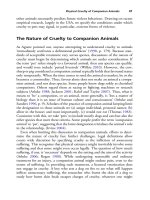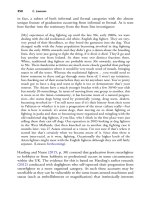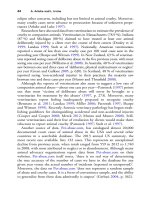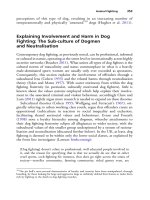The palgrave international handbook of a 53
Bạn đang xem bản rút gọn của tài liệu. Xem và tải ngay bản đầy đủ của tài liệu tại đây (40.75 KB, 1 trang )
Physical Cruelty of Companion Animals
41
other animals necessarily predicts future violent behaviour. Drawing on recent
empirical research, largely in the USA, we specify the conditions under which
cruelty to pets may signal, in particular, extreme forms of violence.
The Nature of Cruelty to Companion Animals
As Agnew pointed out, anyone attempting to understand cruelty to animals
‘immediately confronts a definitional problem’ (1998, p. 179). Because standards of acceptable treatment vary across species, discussions of the nature of
cruelty must begin by determining which animals are under consideration. If
the term ‘pet’ refers simply to a favoured animal, then any species can qualify,
and would even include ‘petted livestock’ (Wilkie 2010). However, the cow,
sheep or pig considered a companion animal typically holds that favoured status
only temporarily. When the time comes to send the animal to market, he or she
becomes a commodity. Thus, favour alone does not make an animal a companion animal, and nor does species. Some people know dogs solely as cherished
companions. Others regard them as racing or fighting machines or research
subjects (Arluke 1988; Jackson 2001; Kalof and Taylor 2007). Thus, what it
means to ‘be’ a companion, or an animal, more generally, is ‘less a matter of
biology than it is an issue of human culture and consciousness’ (Arluke and
Sanders 1996, p. 9). Scholars of the practice of companion animal keeping limit
the designation to those animals we (a) assign individual, personal names; (b)
allow in the house; and most importantly, (c) would not eat (Thomas 1983).
Consistent with this, we take ‘pets’ to include mostly dogs and cats but also the
other species that meet these criteria. Some people prefer the term ‘companion
animal’ to ‘pet’, suggesting that the latter designation trivialises the animal’s role
in the relationship, (Irvine 2004).
Even when limiting this discussion to companion animals, efforts to determine the nature of cruelty face further challenges. Legal definitions allow
courts wide discretion by specifying cruelty as the infliction of unnecessary
suffering. This recognises that physical existence might inevitably involve some
suffering and that some might even occur legally. The question of how much
suffering, if any, is ‘necessary’ depends on the setting and the aim of the activity
(Arluke 2006; Regan 1980). While undergoing reasonable and ordinary
treatment for an injury, a companion animal might endure pain, even to the
extent of suffering. In providing such treatment, a licensed veterinarian does
not engage in cruelty. A boy who sets a dog on fire to see what will happen
inflicts unnecessary suffering; the researcher who burns the skin of a dog to
study how burnt skin heals escapes charges of cruelty, whatever one might









